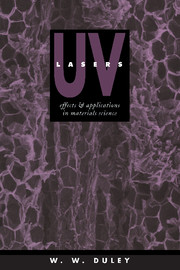Book contents
- Frontmatter
- Contents
- Preface
- Acknowledgments
- 1 Short wavelength lasers
- 2 Optical properties of materials at UV wavelengths
- 3 Photochemical and photothermal effects
- 4 Interaction of UV laser radiation with metals
- 5 Interaction of UV radiation with organic polymers
- 6 Interactions and material removal in inorganic insulators
- 7 UV laser preparation and etching of superconductors
- 8 Interactions and effects in semiconductors
- 9 Laser deposition
- Index
9 - Laser deposition
Published online by Cambridge University Press: 16 November 2009
- Frontmatter
- Contents
- Preface
- Acknowledgments
- 1 Short wavelength lasers
- 2 Optical properties of materials at UV wavelengths
- 3 Photochemical and photothermal effects
- 4 Interaction of UV laser radiation with metals
- 5 Interaction of UV radiation with organic polymers
- 6 Interactions and material removal in inorganic insulators
- 7 UV laser preparation and etching of superconductors
- 8 Interactions and effects in semiconductors
- 9 Laser deposition
- Index
Summary
INTRODUCTION
A wide variety of materials can be deposited from gaseous, solid and liquid precursors using laser techniques. Photothermal as well as photochemical routes are often available and range from the straightforward use of laser radiation as a vaporization source to photochemical decomposition of adsorbed layers. Laser deposition can be used for the creation of extended thin films or for selective deposition of specific features in localized regions with dimensions extending to less than 1 μm. The choice of deposition technique will depend on the required composition of the deposit together with the properties of the substrate. Laser wavelength may be of primary importance for photochemical deposition of sub-micrometer features. Some significant factors in the laser deposition of materials are:
chemical routes to the required deposit,
laser intensity and wavelength,
sensitivity of substrate to thermal/photochemical effects,
sensitivity of substrate to ambient atmosphere/chemical environment,
scale of features to be deposited, i.e. micro/macrofeatures,
required deposition rate,
sensitivity of deposited layer to contamination by secondary products and/or particulates, and
optical configuration required for deposition.
- Type
- Chapter
- Information
- UV LasersEffects and Applications in Materials Science, pp. 357 - 399Publisher: Cambridge University PressPrint publication year: 1996
- 1
- Cited by



